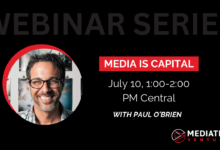
I hate answering a question with a question but I this question keeps coming up so I thought I’d write out a thought; granted, starting with a question: why would they not?
All ad spend is merely a budgeted investment of capital vs. expectations; an intentional allocation of spend to ROI. As long as marketers perceive, or actually account for, a better ROI from “TV,” they’ll spend relatively more there.
It’s that simple. And most marketers are good what at they do…. MOST don’t just throw money at things in hopes that it works. Marketing is the work of determining how and what to advertise; not the advertising itself – but that’s another topic.
Let me take a different approach to the question.
What is “TV”?
Unfortunate in our media industry, thanks to pundits, speakers, and research, is that many still seem to want to distinguish “digital” from traditional channels (print, radio, and television).
That’s unfortunate because “digital” is just a format, a technology, akin to saying “broadcast,” whereas TV is a channel, a medium – that is both broadcast and digital.
A more accurate distinction of channels would never refer to digital. Or video for that matter, nor audio, as those aren’t channels either – those are formats.
Channels might be characterized as:
- TV
- Radio
- Mobile
- Website
- Paper
And on each of those channels (save radio, of course), we can consume:
- Copy / Text
- Video
- Audio
This is an important distinction to start to draw because the overwhelmingly greater % of long-format video consumption is still by way of that in-home, on the couch, in front of a screen delivery mechanism we call Television.
And on that television, people are watching via broadcast, cable, and streaming… through countless channels and apps.
Roku and Amazon Fire TV deliver television into my home, digitally.
I watch the same shows on my smartphone, lying in bed at night. And, when I need a break from my day job of answering questions on Quora, I spin up CBS All Access on my laptop and watch the latest Star Trek Discovery.
Is that all “television”? Where do we draw the distinctions?

[see that chart… that chart doesn’t make any sense… except that it’s a few years out of date… and that it shows how substantial television remains]
I’ve been working online since about 1999 (earlier than that if we count building websites in college). My first job was at Yahoo!, at a time when we were taking over the homepage of the most popular web address in the world, to run “takeover” ads for Britney Spears, Dell, and Sony – ads that would often run videos.
Why don’t we see those anymore? Certainly, not because Yahoo is actually dead; it’s still one of the most heavily trafficked sites on the internet.
Banner Ad “CPMs” (cost per thousand impressions – how online ads are usually packaged and sold) used to demand a rate card price of as much as $30 per thousand. Within the span of the years I spent at Yahoo, almost two decades ago, we saw that average CPM fall to a fraction of that.
Why?
Good question. Let me ask another first: Why is there always such aggravation over ads showing up in YouTube?
That’s “television” isn’t it?
The internet is what we consider an Active Consumption platform. We sit upright (well… not so much anymore thanks to the smartphone), we use a keyboard, we have dozens of tabs/apps open, we can work while we scroll…
Television (the box) is what we consider Passive Consumption. We zone out. We lie down / sit back. We don’t really do anything else but eat. Sure we have a remote and can walk to the kitchen when a commercial plays, but it still plays.
Active Consumption tends to favor Active Engagement Ads while Passive Engagement Ads (banners, audio, or videos) get ignored more capably or even blocked entirely. This is why Google Adwords is such a gold mine – they are active engagement ads: they serve what the audience is seeking at the time that they are seeking it.
Simply put, “Advertising” online usually sucks because no one is paying attention. Appreciate that I’m not comparing Adwords to Television ads; like to like: banner ads, commercials, and audio spots, online, are relatively poor promotions.
Notice that Hulu, Amazon, and Netflix are all working to creep ads back into the paid subscription model that held the promise of no advertising.
Cable, decades ago, was sold on the same premise…
Broadcast Television is free (over the air), so commercials and show sponsors were always part of the experience. Cable came along and since you were paying for it, the promise was fewer commercials (or even none, as was the case with HBO). Thing is, that didn’t last… commercials crept into most of the experience and we started fleeing cable for OTT (Over The Top, as it’s also called), streaming, video… first note, by torrenting videos to get content without commercials – since it was possible; not because we wanted to break the law.
Netflix rose to prominence thanks to their inexpensive alternative to cable and the fact that no one really wants to steal content… again: the promise of affordable television without commercials.
But it didn’t last long and now PAID for streaming television is adding in advertisements.
Note that: Advertising is creeping back into streaming Television. Why? For the same reason television has always been a lion’s share of advertising, even compared to the internet: because it works.







Well I invest in traditional cable, digital media, and digital ads through public equity exposure, so your answer was very, very helpful to figure out the equilibrium between the two. Thank you again for your insightful answer Paul!
There is a far simpler answer. Some companies have a culture that reveres TV and gives it the benefit of the doubt at all costs.